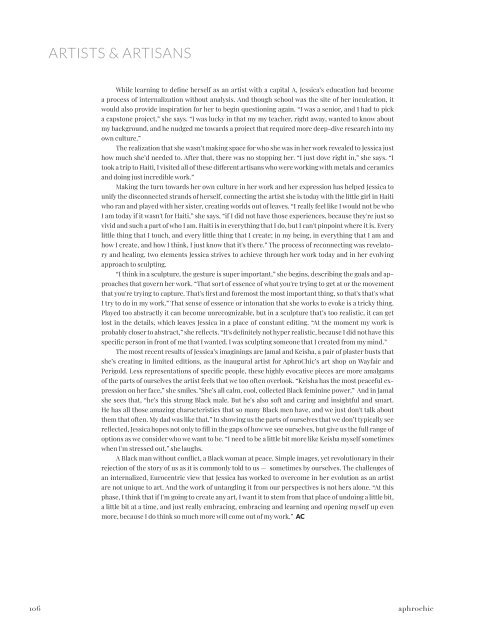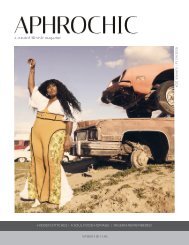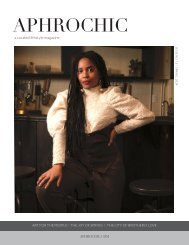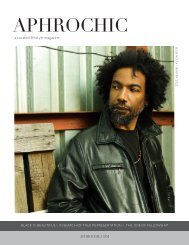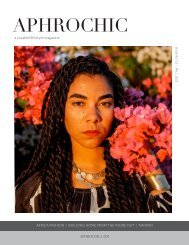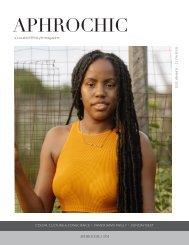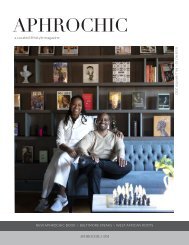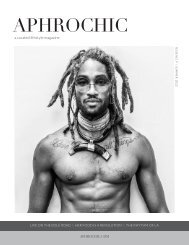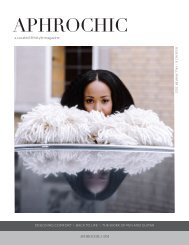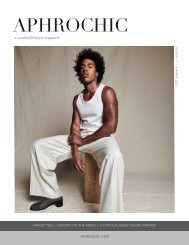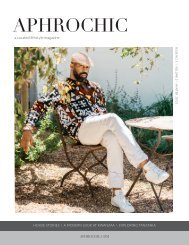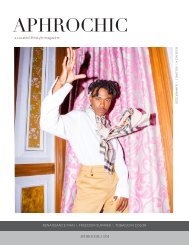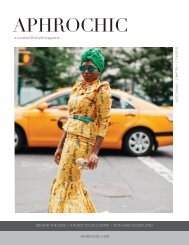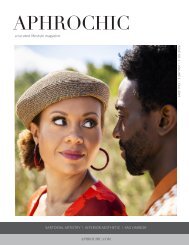AphroChic Magazine: Issue No. 11
You also want an ePaper? Increase the reach of your titles
YUMPU automatically turns print PDFs into web optimized ePapers that Google loves.
ARTISTS & ARTISANS<br />
While learning to define herself as an artist with a capital A, Jessica’s education had become<br />
a process of internalization without analysis. And though school was the site of her inculcation, it<br />
would also provide inspiration for her to begin questioning again. “I was a senior, and I had to pick<br />
a capstone project,” she says. “I was lucky in that my my teacher, right away, wanted to know about<br />
my background, and he nudged me towards a project that required more deep-dive research into my<br />
own culture.”<br />
The realization that she wasn’t making space for who she was in her work revealed to Jessica just<br />
how much she’d needed to. After that, there was no stopping her. “I just dove right in,” she says. “I<br />
took a trip to Haiti, I visited all of these different artisans who were working with metals and ceramics<br />
and doing just incredible work.”<br />
Making the turn towards her own culture in her work and her expression has helped Jessica to<br />
unify the disconnected strands of herself, connecting the artist she is today with the little girl in Haiti<br />
who ran and played with her sister, creating worlds out of leaves. “I really feel like I would not be who<br />
I am today if it wasn't for Haiti,” she says, “if I did not have those experiences, because they're just so<br />
vivid and such a part of who I am. Haiti is in everything that I do, but I can't pinpoint where it is. Every<br />
little thing that I touch, and every little thing that I create; in my being, in everything that I am and<br />
how I create, and how I think, I just know that it's there.” The process of reconnecting was revelatory<br />
and healing, two elements Jessica strives to achieve through her work today and in her evolving<br />
approach to sculpting.<br />
“I think in a sculpture, the gesture is super important,” she begins, describing the goals and approaches<br />
that govern her work. “That sort of essence of what you're trying to get at or the movement<br />
that you're trying to capture. That's first and foremost the most important thing, so that's that's what<br />
I try to do in my work.” That sense of essence or intonation that she works to evoke is a tricky thing.<br />
Played too abstractly it can become unrecognizable, but in a sculpture that’s too realistic, it can get<br />
lost in the details, which leaves Jessica in a place of constant editing. “At the moment my work is<br />
probably closer to abstract,” she reflects. “It's definitely not hyper realistic, because I did not have this<br />
specific person in front of me that I wanted. I was sculpting someone that I created from my mind.”<br />
The most recent results of Jessica’s imaginings are Jamal and Keisha, a pair of plaster busts that<br />
she’s creating in limited editions, as the inaugural artist for <strong>AphroChic</strong>’s art shop on Wayfair and<br />
Perigold. Less representations of specific people, these highly evocative pieces are more amalgams<br />
of the parts of ourselves the artist feels that we too often overlook. “Keisha has the most peaceful expression<br />
on her face,” she smiles. "She’s all calm, cool, collected Black feminine power.” And in Jamal<br />
she sees that, “he’s this strong Black male. But he's also soft and caring and insightful and smart.<br />
He has all those amazing characteristics that so many Black men have, and we just don't talk about<br />
them that often. My dad was like that.” In showing us the parts of ourselves that we don’t typically see<br />
reflected, Jessica hopes not only to fill in the gaps of how we see ourselves, but give us the full range of<br />
options as we consider who we want to be. “I need to be a little bit more like Keisha myself sometimes<br />
when I'm stressed out,” she laughs.<br />
A Black man without conflict, a Black woman at peace. Simple images, yet revolutionary in their<br />
rejection of the story of us as it is commonly told to us — sometimes by ourselves. The challenges of<br />
an internalized, Eurocentric view that Jessica has worked to overcome in her evolution as an artist<br />
are not unique to art. And the work of untangling it from our perspectives is not hers alone. “At this<br />
phase, I think that if I'm going to create any art, I want it to stem from that place of undoing a little bit,<br />
a little bit at a time, and just really embracing, embracing and learning and opening myself up even<br />
more, because I do think so much more will come out of my work.” AC<br />
106 aphrochic


